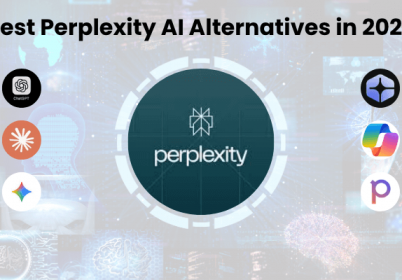How to Use Claude AI: Step-by-Step Guide for Beginners and Professionals

Table of Contents
The landscape of artificial intelligence has transformed dramatically in 2025, with conversational AI becoming essential in our daily digital interactions. Learning how to use Claude AI effectively provides tremendous value for both professionals and casual users in today’s tech landscape.
Developed by Anthropic, Claude AI stands out in the conversational AI space through its unique approach to human-AI interaction. Many users find Claude refreshingly different from other assistants that prioritize feature expansion over thoughtful interactions. The system delivers nuanced responses with enhanced safety protocols and impressive contextual understanding across various scenarios.
Mastering how to use Claude AI unlocks possibilities for more natural, helpful conversations that feel genuinely productive. Claude’s growing popularity stems from its remarkable ability to maintain coherent discussions while adhering to strong ethical guidelines. This comprehensive guide explores everything you need to know about using this remarkable AI assistant in your daily workflow.
Table of Contents
What is Claude AI?
Claude AI represents a sophisticated conversational artificial intelligence assistant created by Anthropic, founded by former OpenAI researchers. The development team designed Claude with core constitutional AI principles that guide every interaction. These foundational principles ensure Claude remains helpful, harmless, and honest throughout all user conversations.
The fundamental objective behind Claude focuses on creating an assistant that maximizes value while minimizing potential risks. Anthropic trained Claude through Constitutional AI techniques and Reinforcement Learning from Human Feedback for optimal performance. This specialized training helps Claude understand complex instructions and respond appropriately across countless interaction scenarios.
Claude excels at understanding nuanced human language and maintaining context throughout extended conversations with remarkable consistency. The assistant analyzes documents, summarizes complex information, drafts various content types, and engages in thoughtful discussions across numerous topics. Anthropic continuously refines Claude through ongoing research that enhances capabilities while maintaining safety guardrails.
Users appreciate Claude for generating helpful responses without overstepping important ethical boundaries in sensitive conversation areas. The system maintains awareness of its limitations and communicates these transparently when encountering topics beyond its capabilities. Claude represents a significant advancement in creating AI systems that genuinely align with human values.
The latest iterations demonstrate impressive capabilities in understanding context, following multi-step instructions, and providing relevant information without hallucinating facts. Anthropic positions Claude as a reliable assistant rather than a replacement for human judgment or specialized expertise. This philosophy shapes every aspect of how Claude functions and responds to user requests.
Key Features of Claude AI
Claude AI distinguishes itself through several remarkable capabilities that create a unique position in the AI assistant landscape. The system demonstrates exceptional natural language understanding that captures subtle conversational nuances often missed by other assistants. Claude comprehends complex instructions, follows multi-part requests, and maintains context throughout lengthy exchanges without losing track.
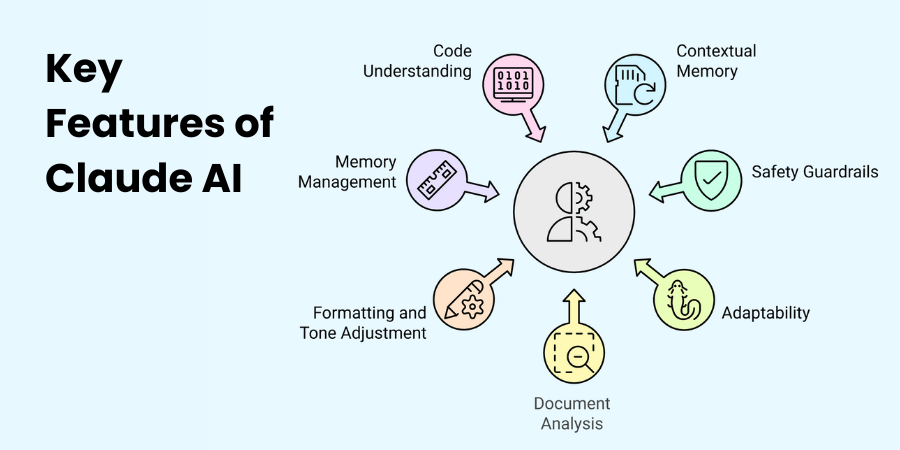
Standout capabilities include:
- Exceptional contextual memory that references information from earlier in conversations
- Comprehensive safety guardrails preventing harmful outputs without sacrificing helpfulness
- Remarkable adaptability across different professional fields and technical domains
- Advanced document analysis with precise information extraction
- Precise formatting and tone adjustment based on specific user preferences
- Effective memory management for extended complex conversations
- Code understanding across multiple programming languages with helpful explanations
The contextual depth represents one of Claude’s most impressive technical achievements in everyday conversations. The AI processes and references information from earlier exchanges without losing track of the discussion flow. This capability enables natural, coherent conversations that feel connected rather than disjointed series of isolated responses.
Safety guardrails form a fundamental aspect of Claude’s design philosophy that users consistently appreciate during sensitive topics. Anthropic built comprehensive safeguards preventing harmful, unethical, or misleading outputs across various potential scenarios. These protections operate without compromising Claude’s helpfulness when handling legitimate requests across numerous knowledge domains.
How to Get Started With Claude AI | Step by Step
Accessing Claude AI requires following a straightforward process that begins with visiting Anthropic’s official website. Navigate to claude.ai and locate the sign-up option prominently displayed on the homepage. Creating an account requires basic information including your email address and a secure password.
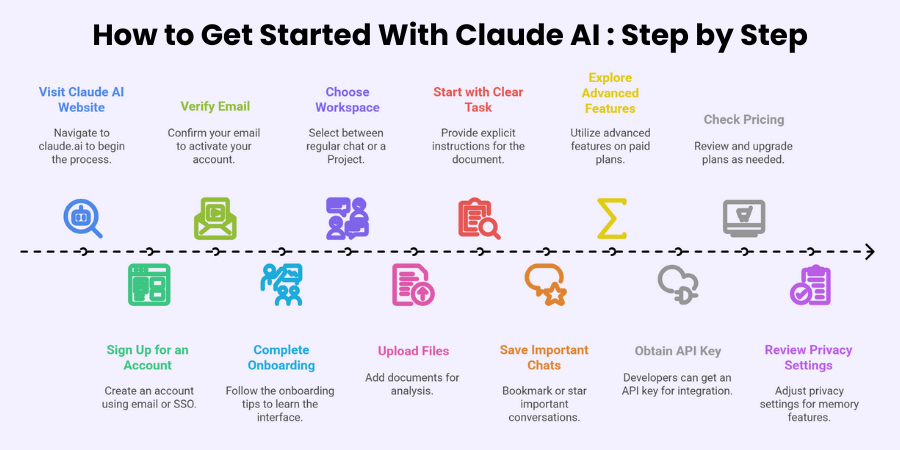
Getting started involves these essential steps:
- Open Claude’s site / console.
Go to Claude’s homepage or the Anthropic console to sign up or sign in. - Choose how you’ll register.
Click Sign up and use your email or a supported single-sign-on (for example, Google). Follow the on-screen form to create a password and accept terms. - Verify your email.
Check your inbox for a confirmation link and click it. Verification activates your account and unlocks the dashboard. - Complete the quick onboarding / getting-started tips.
On first login Claude shows guidance to help you learn the interface and prompt style. Use this to try a few simple questions. - Pick where to work: regular chat or a Project.
If you plan ongoing work with documents, create a プロジェクト (available on paid plans). Projects group related chats and knowledge into one workspace. They let Claude reference uploaded docs while you chat. - Upload files to a Project or chat (document analysis).
Use the upload or “knowledge” area to add documents. Claude supports many file types: PDF, DOCX, CSV, TXT, HTML, ODT, RTF, EPUB, JSON そして XLSX (note: XLSX needs the analysis tool enabled) - Start with a clear task for the document.
Example prompts:
• “Summarize this PDF into five bullet points focused on product risks.”
• “Extract all action items and present them as a todo list.”
Short, explicit instructions give the best outputs. - Star or save important chats.
When you get a reply you want to keep, use the star/bookmark feature to pin it in your sidebar for quick access later. Recent Claude updates also let users search and reference past chats when requested. - Try advanced workspace features (paid plans).
Projects include large context windows and knowledge bases. Paid users can share Projects with teammates and attach many documents to keep Claude “in context” for long projects. - If you’re a developer: get an API key.
Visit the Anthropic console to create an Admin/API key. Then set the key in your environment (for example ANTHROPIC_API_KEY) and use the SDK or HTTP requests. See Anthropic’s “get started” docs for examples. - Check pricing & upgrade if needed.
Claude offers multiple plans (including Free, Pro, and Max tiers). Upgrading can unlock bigger context windows, Projects, Research features, and more usage. Review pricing on Anthropic’s pricing page before you upgrade. - Privacy & features note (recent changes).
Anthropic has introduced optional features that let Claude reference past conversations on demand. Availability may vary by plan and region. If privacy is a concern, review account settings before enabling memory features.
Quick practical tips & prompt templates
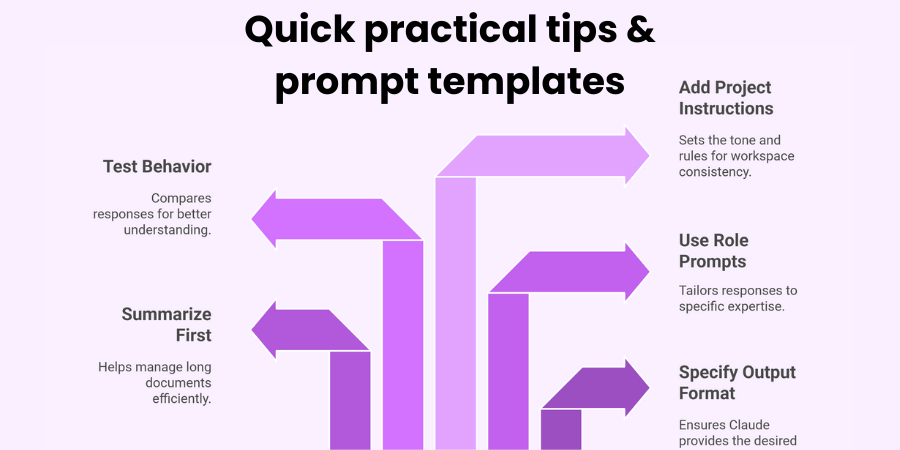
- Always tell Claude the output format: “Give me a 6-point summary with bold headings.”
- For long documents, ask for a summary first, then request deeper sections.
- Use role prompts: “You are an experienced product manager. Review this spec and list three priority risks.”
- To test behavior, ask the same question in two styles (short vs. detailed) and compare responses.
- When using Projects, add a short “project instruction” telling Claude tone and rules for that workspace.
Sample prompt for a report:
Read the uploaded PDF and produce: (1) a 5-bullet executive summary, (2) three immediate action items, and (3) one paragraph on long-term risks.”
After completing registration, verify your email address through the confirmation message sent to your inbox. This verification ensures account security and grants full access to all available features. The process typically takes only a few minutes from start to finish.
New users should complete the welcome tutorial that appears automatically after first login. This orientation provides valuable guidance on capabilities and effective interaction patterns. The tutorial highlights key features and demonstrates communication approaches that produce optimal results.
The Claude interface features a clean, intuitive design with a central conversation area for maximum focus. Users type questions or instructions in the input field located at the bottom of the screen. Claude responds within the conversation thread, maintaining context throughout the entire exchange.
Adjust your communication style based on initial responses to develop more effective interactions. Provide additional context when needed and refine requests if initial responses need improvement. Claude performs best with clear instructions specifying desired format and appropriate detail level.
Mobile users can access Claude through dedicated applications available for iOS and Android devices. The mobile interface maintains core functionality while optimizing the experience for smaller screens. This option enables productive AI assistance while away from your desktop computer.
Advanced Usage of Claude 3
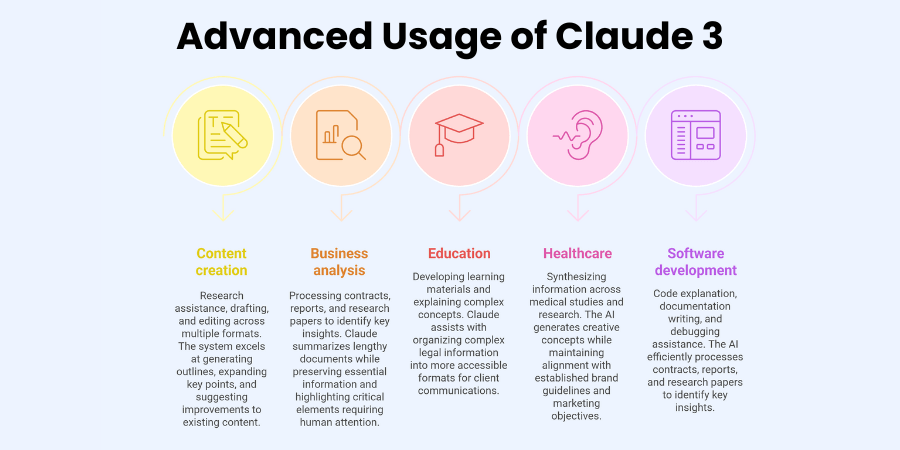
Integrating Claude into existing workflows significantly enhances productivity across various professional environments and technical scenarios. Developers can access Claude’s capabilities through the comprehensive API, enabling seamless integration with custom applications. The detailed API documentation provides implementation guidance across different programming environments and business use cases.
Creating specialized prompts represents a powerful technique for maximizing Claude’s effectiveness in recurring professional scenarios. Expert users develop prompt templates for common tasks that include specific instructions and formatting requirements. These templates ensure consistent, high-quality outputs while reducing the need for extensive clarification.
Professional applications include:
- Content creation: research assistance, drafting, and editing across multiple formats
- Business analysis: processing contracts, reports, and research papers
- Education: developing learning materials and explaining complex concepts
- Healthcare: synthesizing information across medical studies and research
- Software development: code explanation, documentation writing, and debugging assistance
Content creators leverage Claude for research assistance, drafting, and editing across multiple formats with impressive results. The system excels at generating outlines, expanding key points, and suggesting improvements to existing content. Many writers use Claude as a collaborative partner throughout their creative development process.
Business professionals implement Claude for document analysis and information extraction from complex materials with significant time savings. The AI efficiently processes contracts, reports, and research papers to identify key insights. Claude summarizes lengthy documents while preserving essential information and highlighting critical elements requiring human attention.
Legal professionals leverage Claude for contract analysis, legal research, and document preparation with increased efficiency. The system helps identify potential issues in legal documents and suggests clearer language alternatives. Claude assists with organizing complex legal information into more accessible formats for client communications.
Marketing teams utilize Claude for content strategy, audience analysis, and campaign messaging development across multiple channels. The AI generates creative concepts while maintaining alignment with established brand guidelines and marketing objectives. Claude helps teams explore diverse approaches to communication challenges with fresh perspectives.
Financial analysts work with Claude to summarize market reports, identify emerging trends, and organize complex financial data. The system assists with creating clear explanations of financial concepts for different audience knowledge levels. Claude helps translate technical financial information into more accessible language for stakeholder communications.
Claude Pricing Plans
Claude AI offers several pricing tiers designed to accommodate different user needs and usage patterns. The following table outlines key features and limitations of each available plan:
| Plan | Monthly Cost | Message Limit | File Upload | API Access | Priority Support |
| 無料の | $0 | 40 messages/day | Basic files only | No | No |
| Claude Pro | $20 | Unlimited | All file types | Limited | Yes |
| Claude Team | $30/user | Unlimited | All file types | Full | Yes |
| Claude Enterprise | Custom pricing | Unlimited | Enhanced security | Full + Custom | Dedicated manager |
The Free plan provides an excellent introduction to Claude’s capabilities without financial commitment for casual users. Users can explore basic functionality and determine if Claude meets their specific needs. This tier works well for individuals with occasional AI assistance requirements.
Claude Pro represents the most popular option for individual professionals seeking consistent AI assistance. The unlimited messages and comprehensive file handling capabilities support intensive daily usage. Content creators, researchers, and developers select this tier for its balanced combination of features and affordability.
The Team plan introduces collaborative features enabling multiple users to share resources efficiently across departments. Organizations appreciate the administrative controls and usage analytics included at this level. This tier works particularly well for small businesses and departmental implementations requiring coordinated access.
Enterprise customers receive customized solutions tailored to specific organizational requirements and security protocols. This tier includes dedicated support representatives, enhanced data protection, and specialized integration assistance. Large organizations typically select this option for company-wide AI implementation with maximum security.
When comparing Claude with ChatGPT, several distinctions become apparent in their respective approaches and response patterns. Claude generally demonstrates stronger performance in nuanced reasoning tasks and maintaining context in lengthy conversations. The system excels at following complex instructions with multiple components and requirements.
ChatGPT often performs better with creative writing tasks and maintains broader general knowledge across diverse domains. The system benefits from extensive integration with third-party plugins that extend its functionality. Many users find ChatGPT more accessible for quick, general-purpose queries.
Limitations of Claude AI
Despite impressive capabilities, Claude AI faces several technical constraints that affect performance in specific scenarios. The system occasionally struggles with highly specialized domain knowledge outside its training data. Users working in niche fields may encounter limitations when discussing cutting-edge concepts or specialized terminology.
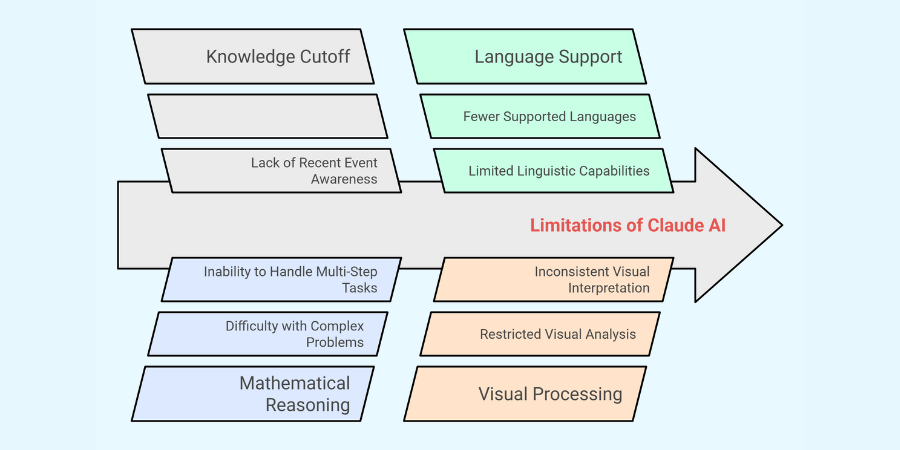
Key limitations include:
- Knowledge cutoff date affecting awareness of recent events and developments
- Challenges with complex mathematical reasoning and multi-step problems
- Limited language support compared to some competing AI systems
- Restricted visual processing capabilities despite recent improvements
- Inconsistency in response quality across different interaction sessions
Claude’s knowledge cutoff date represents a significant limitation for time-sensitive information needs in rapidly changing fields. The system lacks awareness of events, developments, and publications occurring after its training cutoff. This restriction affects Claude’s utility for current news analysis and evolving topics requiring recent information.
Mathematical reasoning presents challenges for Claude, particularly with complex calculations or multi-step problems requiring specialized knowledge. While the system handles basic arithmetic effectively, advanced mathematical concepts may receive incomplete or incorrect treatment. Users should verify important calculations through alternative methods for complete accuracy.
Claude occasionally exhibits inconsistency in response quality across different interaction sessions depending on question formulation. The system may provide detailed, nuanced answers in one instance but more superficial responses later. This variability can create unpredictable user experiences requiring additional prompting for consistent results.
The AI sometimes struggles with ambiguous instructions or requests lacking clear parameters for expected outputs. Claude performs best with specific, well-defined queries rather than open-ended or vague prompts. Users must often refine their communication approach to obtain optimal results.
Privacy considerations represent another important limitation for sensitive applications requiring maximum data protection. While Anthropic maintains strong security protocols, users should avoid sharing highly confidential information through Claude. Organizations with strict data handling requirements should review Anthropic’s privacy policies carefully.
Conclusion
Claude AI is a powerful, accessible tool that supports a wide range of professional and personal applications. Its intuitive onboarding and user-friendly interface make it easy for beginners to start, while advanced users benefit from its adaptability, contextual understanding, and integration capabilities. The free plan is ideal for exploration, with paid tiers offering greater value for professional needs. Though it has limitations, ongoing updates continually expand its features. By providing clear instructions and realistic expectations, users can maximize Claude’s potential as a reliable and versatile assistant. With thoughtful use, it can streamline workflows, inspire creative solutions, and enhance decision-making. As Anthropic continues refining the system, Claude is likely to become an even more indispensable AI companion in the future.
Frequently Asked Questions
Can Claude AI access the internet?
Claude cannot browse the internet independently or access real-time information from online sources. The system relies on knowledge from its training data and information provided during conversations. Users must supply relevant external information when discussing current events or recent developments.
How does Claude handle sensitive personal information?
Claude is designed to decline requests for storing or processing highly sensitive personal information. Anthropic implements privacy protections that prevent the system from retaining confidential data. Users should avoid sharing sensitive financial, medical, or identification information during conversations.
Can Claude generate images or process visual content?
Claude can analyze and describe images uploaded by users but cannot independently generate visual content. The system processes visual information with increasing accuracy but performs best with text-based tasks. Visual analysis capabilities continue improving through ongoing development efforts.
Does Claude work in languages other than English?
Claude performs best in English but offers limited functionality in several other major languages. The system demonstrates reduced capabilities regarding nuance, context, and specialized terminology when operating in non-English languages. Anthropic continues expanding language support through model improvements.
How does Claude compare to other AI assistants for coding tasks?
Claude demonstrates strong capabilities for code explanation, documentation, and debugging assistance across multiple programming languages. The system helps identify logical errors and suggests improvements to existing code. Many developers find Claude particularly helpful for understanding complex codebases and learning new programming concepts.
Shaif Azad
Related Post
Top 10 AI Development Companies in Illinois
Are you ready to discover how Illinois has quietly become one of the most exciting AI...
Best Perplexity AI Alternatives : Top Research Companions
Are you someone who has fallen in love with AI-powered search but finds yourself wondering if...
Top 5 AI Development Companies in Idaho to Watch
Have you watched Idaho transform from an agricultural state into a thriving technology hub? Your business...


